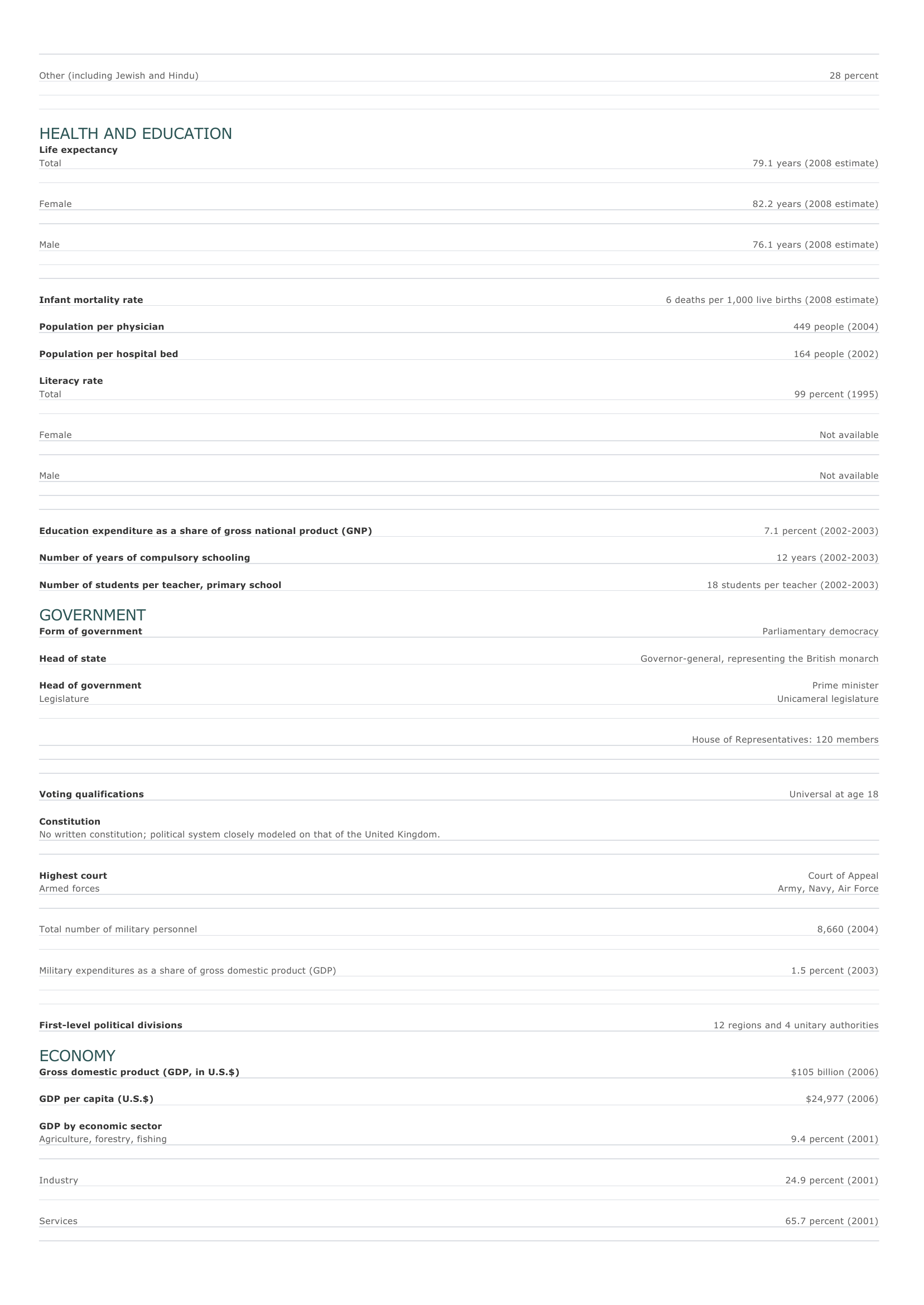New Zealand Facts and Figures. BASIC FACTS Official name Capital Area New Zealand Wellington 270,534 sq km 104,454 sq mi PEOPLE Population 4,154,311 (2008 estimate) Population growth Population growth rate 0.91 percent (2008 estimate) Projected population in 2025 4,672,537 (2025 estimate) Projected population in 2050 4,842,397 (2050 estimate) Population density 16 persons per sq km (2008 estimate) 40 persons per sq mi (2008 estimate) Urban/rural distribution Share urban 86 percent (2005 estimate) Share rural 14 percent (2005 estimate) Largest cities, with population Auckland 404,658 (2006) Wellington 370,100 (2005 estimate) Christchurch 367,800 (2005 estimate) Hamilton 185,100 (2005 estimate) D unedin 114,800 (2005 estimate) Ethnic groups European 75 percent Maori 15 percent Pacific Islander 5 percent Other (including Asian) 5 percent Languages English (official), Maori (official), Polynesian languages Religious affiliations Protestant 24 percent Anglican 21 percent Roman Catholic 13 percent Buddhist Nonreligious 1 percent 13 percent Other (including Jewish and Hindu) 28 percent HEALTH AND EDUCATION Life expectancy Total 79.1 years (2008 estimate) Female 82.2 years (2008 estimate) Male 76.1 years (2008 estimate) Infant mortality rate 6 deaths per 1,000 live births (2008 estimate) Population per physician 449 people (2004) Population per hospital bed 164 people (2002) Literacy rate Total 99 percent (1995) Female Not available Male Not available Education expenditure as a share of gross national product (GNP) Number of years of compulsory schooling Number of students per teacher, primary school 7.1 percent (2002-2003) 12 years (2002-2003) 18 students per teacher (2002-2003) GOVERNMENT Form of government Head of state Head of government Legislature Parliamentary democracy Governor-general, representing the British monarch Prime minister Unicameral legislature House of Representatives: 120 members Voting qualifications Universal at age 18 Constitution No written constitution; political system closely modeled on that of the United Kingdom. Highest court Armed forces Total number of military personnel Military expenditures as a share of gross domestic product (GDP) First-level political divisions Court of Appeal Army, Navy, Air Force 8,660 (2004) 1.5 percent (2003) 12 regions and 4 unitary authorities ECONOMY Gross domestic product (GDP, in U.S.$) GDP per capita (U.S.$) GDP by economic sector Agriculture, forestry, fishing $105 billion (2006) $24,977 (2006) 9.4 percent (2001) I ndustry 24.9 percent (2001) Services 65.7 percent (2001) Employment Number of workers Workforce share of economic sector Agriculture, forestry, fishing 2,219,464 (2006) 7 percent (2005) I ndustry 22 percent (2005) Services 71 percent (2005) Unemployment rate 3.9 percent (2004) National budget (U.S.$) Total revenue $41.35 billion (2006) Total expenditure $35.23 billion (2006) Monetary unit 1 New Zealand dollar ($NZ), consisting of 100 cents Agriculture Wool, barley, wheat, maize, oats, fruits and vegetables, livestock Mining Coal, petroleum and natural gas, gold, iron ore, bentonite, silica sand Manufacturing Meat and dairy products, paper and paper products, chemicals, metal products, machinery, clothing, lumber, motor vehicles, electrical machinery, refined petroleum, printed materials Major exports Dairy products, wool, fish, meat, fruit and vegetables Major imports Manufactured goods, heavy machinery, petroleum, chemicals, iron and steel, plastic materials, textiles Major trade partners for exports Australia, United States, Japan, United Kingdom, and South Korea Major trade partners for imports Australia, United States, Japan, China, and Germany ENERGY, COMMUNICATIONS, AND TRANSPORTATION Electricity production Electricity from thermal sources 31.06 percent (2003 estimate) Electricity from hydroelectric sources 59.14 percent (2003 estimate) Electricity from nuclear sources Electricity from geothermal, solar, and wind sources 0 percent (2003 estimate) 9.79 percent (2003 estimate) Number of radios per 1,000 people 997 (1997) Number of telephones per 1,000 people 422 (2005) Number of televisions per 1,000 people 541 (2000 estimate) Number of Internet hosts per 10,000 people 1,183 (2003) Daily newspaper circulation per 1,000 people 362 (2000) Number of motor vehicles per 1,000 people 701 (2004) Paved road as a share of total roads 64 percent (2003) SOURCES Basic Facts and People sections Area data are from the statistical bureaus of individual countries. Population, population growth rate, and population projections are from the United States Census Bureau, International Programs Center, International Data Base (IDB) (www.census.gov). Urban and rural population data are from the Food and Agriculture Organization (FAO) of the United Nations (UN), FAOSTAT database (www.fao.org). Largest cities population data and political divisions data are from the statistical bureaus of individual countries. Ethnic divisions and religion data are largely from the latest Central Intelligence Agency (CIA) World Factbook and from various country censuses and reports. Language data are largely from the Ethnologue, Languages of the World, Summer Institute of Linguistics International (www.sil.org). Health and Education section Life expectancy and infant mortality data are from the United States Census Bureau, International Programs Center, International database (IDB) (www.census.gov). Population per physician and population per hospital bed data are from the World Health Organization (WHO) (www.who.int). Education data are from the United Nations Educational, Scientific and Cultural Organization (UNESCO) database (www.unesco.org). Government section Government, independence, legislature, constitution, highest court, and voting qualifications data are largely from various government Web sites, the latest Europa World Yearbook, and the latest Central Intelligence Agency (CIA) World Factbook. The armed forces data is from Military Balance. Economy section Gross domestic product (GDP), GDP per capita, GDP by economic sectors, employment, and national budget data are from the World Bank database (www.worldbank.org). Monetary unit, agriculture, mining, manufacturing, exports, imports, and major trade partner information is from the statistical bureaus of individual countries, latest Europa World Yearbook, and various United Nations and International Monetary Fund (IMF) publications. Energy, Communication, and Transportation section Electricity information is from the Energy Information Administration (EIA) database (www.eia.doe.gov). Radio, telephone, television, and newspaper information is from the United Nations Educational, Scientific and Cultural Organization (UNESCO) database (www.unesco.org). Internet hosts, motor vehicles, and road data are from the World Bank database (www.worldbank.org). Note Figures may not total 100 percent due to rounding. Microsoft ® Encarta ® 2009. © 1993-2008 Microsoft Corporation. All rights reserved.



